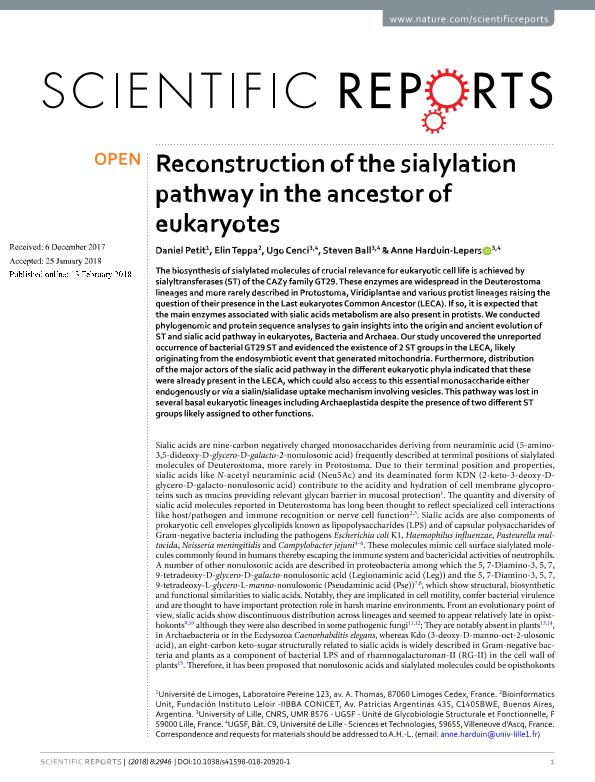Mostrar el registro sencillo del ítem
dc.contributor.author
Petit, Daniel
dc.contributor.author
Teppa, Roxana Elin

dc.contributor.author
Cenci, Ugo
dc.contributor.author
Ball, Steven
dc.contributor.author
Harduin Lepers, Anne
dc.date.available
2019-11-12T19:34:12Z
dc.date.issued
2018-12
dc.identifier.citation
Petit, Daniel; Teppa, Roxana Elin; Cenci, Ugo; Ball, Steven; Harduin Lepers, Anne; Reconstruction of the sialylation pathway in the ancestor of eukaryotes; Nature Publishing Group; Scientific Reports; 8; 1; 12-2018; 1-13
dc.identifier.issn
2045-2322
dc.identifier.uri
http://hdl.handle.net/11336/88676
dc.description.abstract
The biosynthesis of sialylated molecules of crucial relevance for eukaryotic cell life is achieved by sialyltransferases (ST) of the CAZy family GT29. These enzymes are widespread in the Deuterostoma lineages and more rarely described in Protostoma, Viridiplantae and various protist lineages raising the question of their presence in the Last eukaryotes Common Ancestor (LECA). If so, it is expected that the main enzymes associated with sialic acids metabolism are also present in protists. We conducted phylogenomic and protein sequence analyses to gain insights into the origin and ancient evolution of ST and sialic acid pathway in eukaryotes, Bacteria and Archaea. Our study uncovered the unreported occurrence of bacterial GT29 ST and evidenced the existence of 2 ST groups in the LECA, likely originating from the endosymbiotic event that generated mitochondria. Furthermore, distribution of the major actors of the sialic acid pathway in the different eukaryotic phyla indicated that these were already present in the LECA, which could also access to this essential monosaccharide either endogenously or via a sialin/sialidase uptake mechanism involving vesicles. This pathway was lost in several basal eukaryotic lineages including Archaeplastida despite the presence of two different ST groups likely assigned to other functions.
dc.format
application/pdf
dc.language.iso
eng
dc.publisher
Nature Publishing Group

dc.rights
info:eu-repo/semantics/openAccess
dc.rights.uri
https://creativecommons.org/licenses/by-nc-sa/2.5/ar/
dc.subject
sialyltransferases
dc.subject
sialylation pathway
dc.subject
Last eukaryotes Common Ancestor
dc.subject
GT29
dc.subject.classification
Otras Ciencias Biológicas

dc.subject.classification
Ciencias Biológicas

dc.subject.classification
CIENCIAS NATURALES Y EXACTAS

dc.title
Reconstruction of the sialylation pathway in the ancestor of eukaryotes
dc.type
info:eu-repo/semantics/article
dc.type
info:ar-repo/semantics/artículo
dc.type
info:eu-repo/semantics/publishedVersion
dc.date.updated
2019-10-22T17:32:41Z
dc.journal.volume
8
dc.journal.number
1
dc.journal.pagination
1-13
dc.journal.pais
Reino Unido

dc.journal.ciudad
Londres
dc.description.fil
Fil: Petit, Daniel. Université de Limoges; Francia
dc.description.fil
Fil: Teppa, Roxana Elin. Consejo Nacional de Investigaciones Científicas y Técnicas. Oficina de Coordinación Administrativa Parque Centenario. Instituto de Investigaciones Bioquímicas de Buenos Aires. Fundación Instituto Leloir. Instituto de Investigaciones Bioquímicas de Buenos Aires; Argentina
dc.description.fil
Fil: Cenci, Ugo. Universite Lille; Francia
dc.description.fil
Fil: Ball, Steven. Universite Lille; Francia
dc.description.fil
Fil: Harduin Lepers, Anne. Universite Lille; Francia
dc.journal.title
Scientific Reports
dc.relation.alternativeid
info:eu-repo/semantics/altIdentifier/doi/http://dx.doi.org/10.1038/s41598-018-20920-1
dc.relation.alternativeid
info:eu-repo/semantics/altIdentifier/url/https://www.nature.com/articles/s41598-018-20920-1
Archivos asociados
